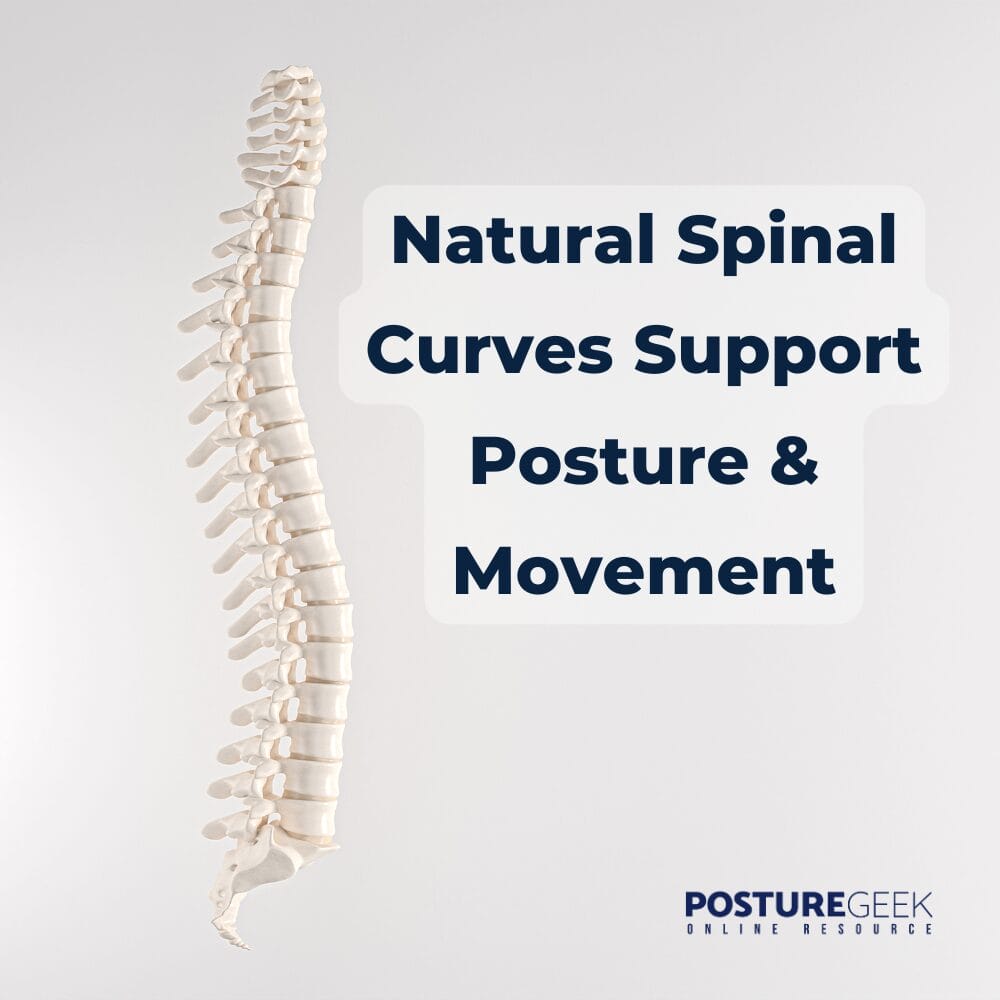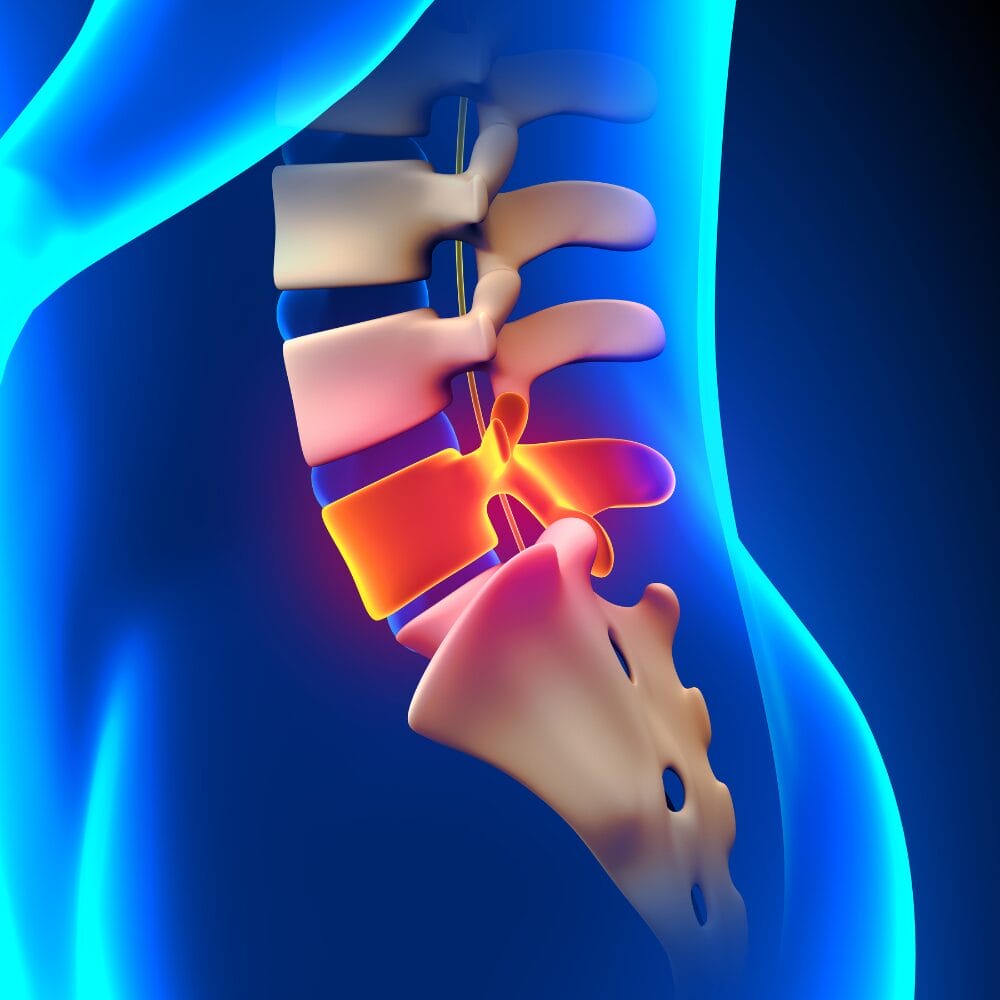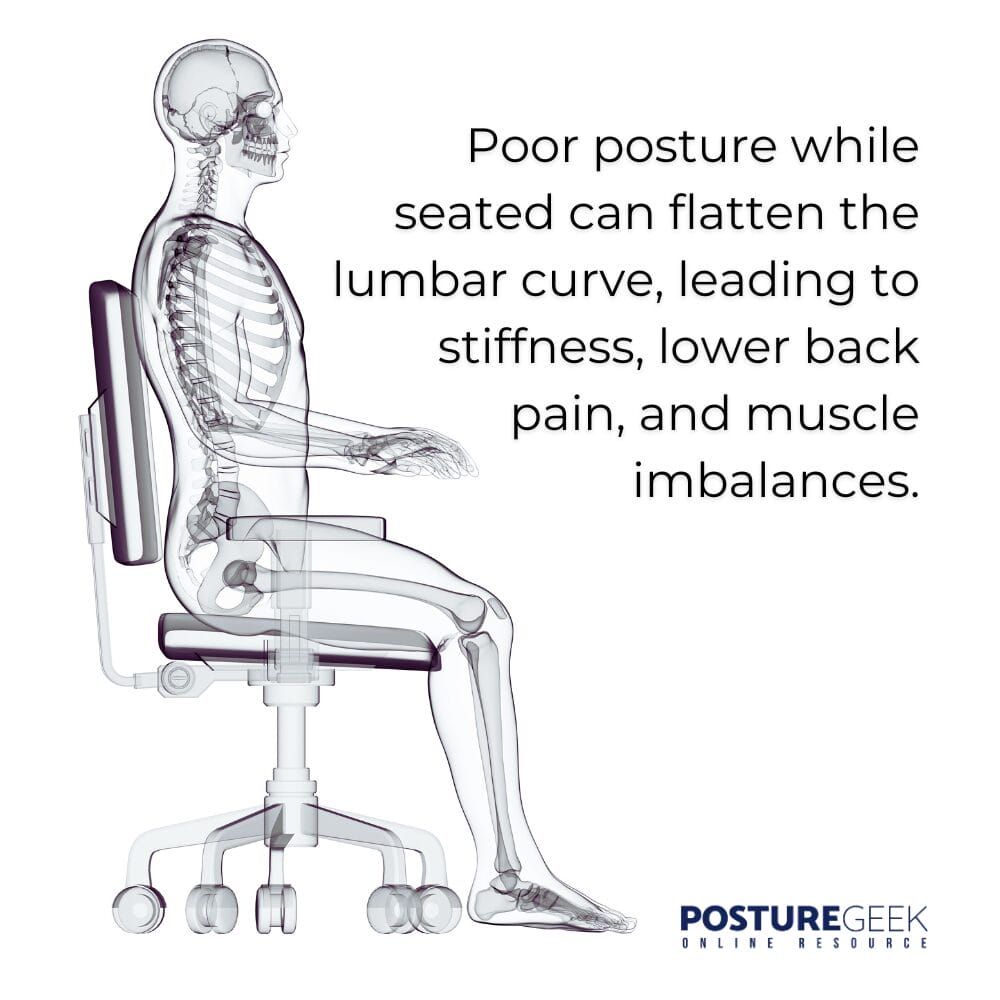Lumbar Curve Explained: How It Affects Your Posture, Pain & Health
- Updated - February 26, 2025
Your lumbar curve is more than just a natural bend in your lower back—it’s a critical component of spinal health, movement efficiency, and pain prevention. Whether you spend long hours at a desk, lift weights at the gym, or simply want to maintain good posture, your lumbar spine plays a key role in overall well-being.
This post explores why the lumbar curve matters, what happens when it’s compromised, and how you can maintain a strong, pain-free lower back.
Understanding the Lumbar Curve
The lumbar spine consists of five vertebrae (L1-L5) that form a natural inward curve, known as lumbar lordosis. This curve is essential for:
- Absorbing shock from daily movements like walking and lifting
- Distributing body weight evenly to reduce pressure on any single area
- Maintaining balance and posture during movement
When the lumbar curve is too exaggerated (hyperlordosis) or too flat (hypolordosis), it can lead to pain, dysfunction, and long-term spinal issues.
The cervical spine (neck) also has a natural lordotic curve, mirroring the lumbar region’s inward curvature. Together, these two curves play a vital role in maintaining a stable and upright posture. When one is misaligned, it can create compensations throughout the spine, affecting everything from neck tension to lower back pain.
Why Is the Lumbar Curve Important?

1. Supports Spinal Alignment & Posture
A healthy lumbar curve keeps the spine properly aligned, reducing stress on muscles and joints. Since the cervical spine also follows a natural lordotic curve, the two regions work together to support proper head and body posture.
When the lumbar curve is too flat, it often leads to a forward head posture, straining the neck and upper back. Conversely, excessive lumbar lordosis can shift the body’s center of gravity, forcing the neck to compensate increasing stress on the cervical spine.
2. Absorbs Shock and Distributes Load Efficiently
Your lumbar spine absorbs forces from walking, running, and bending. A well-balanced curve:
- Prevents excessive wear and tear on vertebrae and discs
- Distributes load evenly between the lower back, pelvis, and legs
- Reduces the risk of herniated discs and degenerative conditions
If the lumbar curve is too flat or too arched, it increases pressure on the spine, leading to pain and mobility issues.
3. Enhances Core Stability & Movement Efficiency
The lumbar spine works with the core muscles to provide stability. When properly aligned, it:
- Creates a strong foundation for movements like bending, twisting, and lifting
- Prevents overuse of the lower back muscles, reducing strain and fatigue
- Supports efficient movement, reducing the risk of injuries
A weak or misaligned lumbar curve forces other muscles (like the lower back and hip flexors) to compensate, increasing the risk of pain, stiffness, and imbalances.
4. Protects Nerve Health & Circulation
The cauda equina, a bundle of nerves in the lower back, controls leg movement and lower body functions. A compromised lumbar curve can:
- Compress nerves, causing pain, numbness, or weakness in the legs (sciatica)
- Restrict blood flow, leading to stiffness and reduced mobility
- Affect bladder and bowel function in severe cases
Maintaining a healthy lumbar curve protects nerve function and preserves full-body mobility.
5. Improves Breathing & Organ Function
Lumbar alignment influences diaphragm and rib cage movement, affecting breathing efficiency and organ function. A healthy lumbar curve:
- Supports deep diaphragmatic breathing, improving oxygen intake
- Prevents excessive abdominal compression, protecting digestion and pelvic health
- Maintains proper rib cage mobility, ensuring efficient lung expansion
A flattened lumbar curve can lead to shallow breathing and increased tension in the upper body.
Postural imbalances in the lumbar spine influence breathing mechanics and organ function, but the cervical spine also plays a role in this process. Poor cervical alignment can restrict airflow, affecting the efficiency of diaphragmatic breathing. Maintaining both lumbar and cervical lordosis helps ensure optimal respiratory function and spinal balance.
Discover a practitioner near you.
Looking for a practitioner near you? Our extensive network of qualified professionals is here to help you.
How Is Lumbar Curve Health Diagnosed?

Assessing the health and alignment of the lumbar curve is a critical step in identifying postural imbalances, movement dysfunctions, and potential spinal conditions. Diagnosis involves a combination of clinical evaluation, movement assessment, and imaging studies, depending on the severity of symptoms.
1. Postural and Physical Examination
A healthcare professional, such as a physical therapist, chiropractor, or orthopedic specialist, will begin by evaluating your posture, spinal alignment, and movement patterns. This may include:
- Visual Inspection: Observing whether the lumbar curve is excessively arched (hyperlordosis) or too flat (hypolordosis) while standing, sitting, and walking.
- Palpation: Feeling for muscle tightness, asymmetry, or tenderness in the lower back and pelvis.
- Range of Motion Tests: Assessing how well the spine, hips, and pelvis move together during bending, twisting, and other functional movements.
- Leg Length & Pelvic Alignment: Checking for imbalances in leg length or pelvic tilt, which can influence lumbar curvature.
2. Functional Movement Tests
To determine how well the lumbar spine interacts with the rest of the body, specific movement tests may be used:
- Modified Schober’s Test – Measures lumbar flexion (forward bending ability) to assess spine mobility and flexibility.
- Thomas Test – Identifies hip flexor tightness, which can contribute to an exaggerated lumbar curve (hyperlordosis).
- Sit-to-Stand Test – Evaluates pelvic control and core activation while transitioning from sitting to standing.
- Plank Hold & Bridge Test – Assesses core strength and glute activation, which are essential for maintaining lumbar stability.
3. Imaging Tests (If Needed)
If there are concerns about structural abnormalities, chronic pain, or suspected spinal disorders, imaging studies may be recommended to get a clearer view of the lumbar spine.
- X-rays – Provide a detailed look at spinal curvature and can measure the degree of lumbar lordosis.
- MRI (Magnetic Resonance Imaging) – Useful for evaluating soft tissues, discs, and nerve compression, especially if symptoms include radiating pain or numbness.
- CT Scan (Computed Tomography) – This may be used in cases where detailed cross-sectional imaging is needed for diagnosing fractures, arthritis, or severe degenerative changes.
Key Diagnostic Indicator:
- A normal lumbar lordosis angle typically ranges between 30-50 degrees, depending on individual anatomy. A curve outside this range may indicate hyperlordosis (excessive curvature) or hypolordosis (flattened curve).
4. Gait & Biomechanical Analysis
In some cases, gait analysis is performed to assess how lumbar posture affects movement mechanics. Using motion-tracking technology or video assessments, clinicians can identify:
- How the lumbar curve shifts during walking and running
- Compensatory patterns in the hips, knees, or feet
- Muscle imbalances affecting spinal alignment
This type of assessment is particularly valuable for athletes, individuals with chronic pain, or those experiencing lower back stiffness after prolonged standing or walking.
When Should You Get Your Lumbar Curve Evaluated?
While some variations in lumbar curvature are normal and functional, it’s important to get an evaluation if you experience:
- Chronic or recurring lower back pain
- Difficulty maintaining good posture
- Hip, knee, or lower body imbalances
- Pain that worsens with prolonged sitting, standing, or movement
- Numbness, tingling, or radiating pain into the legs (possible nerve compression)
Diagnosing lumbar curve issues requires a holistic approach, considering both postural assessment and functional movement. If you suspect your lumbar curve may be excessively arched or flattened, seeking a professional evaluation can help prevent long-term complications and guide you toward targeted solutions for better spinal health.
Common Lumbar Curve Issues & Their Causes

Several conditions can affect the lumbar curve, leading to discomfort, movement restrictions, and long-term spinal problems. These issues typically result from muscle imbalances, postural habits, or structural abnormalities that alter the spine’s natural curvature.
Below are the two most common lumbar curve issues:
1. Hyperlordosis (Excessive Lumbar Curve)
What Is Hyperlordosis?
Hyperlordosis, also known as swayback, occurs when the lower back is excessively arched inward, causing an over-exaggeration of the lumbar curve. This condition shifts the pelvis forward and places excessive pressure on the lower spine, leading to discomfort and mobility issues.
Symptoms of Hyperlordosis:
- Increased curvature of the lower back, making the buttocks protrude outward
- Lower back pain and stiffness, especially after standing or walking for extended periods
- Hip pain due to altered pelvic positioning
- Weakness in the core muscles, leading to poor postural control
- Tightness in the hip flexors and lower back muscles
- Possible nerve compression, leading to numbness or tingling in the legs
How Does Hyperlordosis Affect the Body?
- Increases pressure on the facet joints, accelerating joint wear and leading to potential arthritis or disc issues
- Weakens the abdominal muscles, which reduces spinal stability and increases reliance on the lower back for support
- Creates imbalances in the lower body, leading to tight hip flexors and overworked hamstrings
- Alters gait and movement efficiency, increasing the risk of knee and hip problems.
Common Causes of Hyperlordosis:
- Prolonged sitting: Sitting for extended periods shortens the hip flexors (e.g., iliopsoas), pulling the pelvis forward and deepening the lumbar curve
- Weak core muscles: A weak core fails to support the spine, allowing the lower back to overcompensate
- Wearing high heels: High heels shift body weight forward, forcing the lower back to arch excessively to maintain balance
- Excess body weight: Extra weight, especially in the abdomen, increases the forward pull on the lumbar spine
- Poor posture habits: Standing or walking with an exaggerated arch in the back reinforces the excessive curve
- Pregnancy: Increased abdominal weight and shifting posture can contribute to hyperlordosis, though it often corrects postpartum
- Imbalanced training: Strengthening only the back muscles without core and glute engagement leads to excessive lordotic curvature
How to Address Hyperlordosis:
- Strengthen the core muscles (abdominals, obliques, transverse abdominis) to support the lumbar spine.
- Stretch tight hip flexors and lower back muscles to reduce excessive curvature.
- Focus on glute and hamstring activation to maintain pelvic balance.
- Use proper ergonomic seating to prevent excessive hip flexor tightness.
- Wear supportive footwear to avoid excessive forward tilt of the pelvis.
2. Hypolordosis (Flattened Lumbar Curve)
What Is Hypolordosis?
Hypolordosis, or flattened lumbar curve, occurs when the natural inward curve of the lower back is reduced, making the spine appear straight or even slightly curved outward. This results in a stiff, immobile lower back that struggles to absorb shock properly, leading to increased stress on the intervertebral discs and muscles.
Symptoms of Hypolordosis:
- Lower back pain due to poor spinal shock absorption
- Restricted spinal movement, making it difficult to bend or twist comfortably
- Forward head posture and rounded shoulders, as the body compensates for the lack of lumbar curve
- Tight hamstrings and weak hip flexors contribute to postural imbalances.
- Increased risk of herniated discs and nerve compression
How Does Hypolordosis Affect the Body?
- Increases pressure on the lumbar discs, which can accelerate disc degeneration and increase the risk of bulging or herniated discs
- Reduces spinal mobility, leading to stiffness and inefficient movement patterns
- It affects full-body posture, forcing compensations in the thoracic and cervical spine, leading to neck and upper back tension.
- Weakens postural muscles, particularly the deep stabilizers of the lower back, making everyday activities more fatiguing
Common Causes of Hypolordosis:
- Sedentary lifestyle: Prolonged sitting, especially with poor posture, weakens spinal support muscles, leading to a flattened lumbar curve
- Tight hamstrings and weak hip flexors: These muscle imbalances pull the pelvis backward, reducing the natural lumbar arch
- Chronic lower back pain: Pain or injury can cause protective muscle guarding, where muscles tighten and restrict movement, flattening the lumbar spine
- Poor sleeping positions: Sleeping on a mattress with inadequate support or in a curled fetal position can gradually reduce lumbar curvature
- Muscle imbalances from training: Overemphasizing posterior chain exercises (e.g., deadlifts, hamstring curls) without core engagement can contribute to lumbar flattening
- Spinal conditions: Some conditions, such as ankylosing spondylitis, can lead to progressive loss of spinal curvature
How to Address Hypolordosis:
- Improve core strength (especially deep stabilizers like the transverse abdominis) to support lumbar curvature.
- Stretch tight hamstrings and posterior chain muscles to allow proper pelvic positioning.
- Use lumbar support when sitting for extended periods to maintain the natural spinal curve.
- Engage in posture training to encourage proper standing and walking mechanics.
- Avoid excessive rounding of the back during exercises, such as squats and deadlifts.
How to Maintain a Healthy Lumbar Curve

Keeping your lumbar spine in proper alignment is essential for spinal health, movement efficiency, and long-term pain prevention. While the following topics are explored in more depth in other PostureGeek blog posts, they are all critical components of maintaining a well-balanced lumbar curve.
1. Improve Your Sitting Posture

Sitting for extended periods is one of the most common causes of lumbar misalignment. Poor posture while seated can flatten the lumbar curve, leading to stiffness, lower back pain, and muscle imbalances.
Best Practices for Sitting Posture:
- Sit with hips slightly higher than knees – This encourages the pelvis to stay neutral, preventing excessive lumbar flattening.
- Use a lumbar support cushion – A small support placed in the lower back can help maintain the natural curve.
- Keep feet flat on the floor – Crossing legs or tucking feet under the chair can shift the pelvis into an unnatural position.
- Avoid prolonged sitting – Stand up and move every 30-60 minutes to prevent stiffness and promote circulation.
- Position your screen at eye level – Looking down at a screen can pull the head and upper spine forward, creating compensations that affect lumbar alignment.
Many people unknowingly develop posterior pelvic tilt from prolonged sitting, which flattens the lumbar curve. Correcting sitting habits can alleviate pressure on the lower spine and reduce long-term strain.
2. Strengthen Your Core & Glutes
The lumbar spine relies on strong core and glute muscles for proper support. Without this muscular stability, the lower back is forced to compensate, leading to excessive curvature (hyperlordosis) or flattening (hypolordosis).
Key Exercises to Strengthen Core & Glutes:
- Planks – A core-stabilizing exercise that engages deep abdominal muscles without overloading the lumbar spine.
- Glute Bridges – Helps maintain pelvic alignment by activating the gluteus maximus, reducing reliance on the lower back.
- Squats & Lunges – Engages core, glutes, and legs in a coordinated movement pattern, reinforcing proper lumbar stability.
- Dead Bugs & Bird Dogs – Encourages lumbar control while integrating core activation with movement.
A strong core reduces spinal compression and prevents excessive lumbar arching. Likewise, glute strength ensures proper pelvic positioning, keeping the lumbar curve balanced during movement.
3. Stretch Tight Muscles
Muscle tightness can pull the pelvis and spine out of alignment, leading to an altered lumbar curve. Addressing tight muscles through stretching and mobility work is essential for maintaining a healthy lower back.
Key Areas to Stretch:
- Hip Flexors – Tight psoas and rectus femoris muscles can pull the pelvis forward, deepening the lumbar curve (hyperlordosis). Stretching these muscles helps maintain neutral alignment.
- Hamstrings – When tight, hamstrings pull the pelvis into a posterior tilt, flattening the lumbar spine and increasing stress on the lower back.
- Lower Back Mobility Work – Gentle lumbar extensions, side bends, and rotations can help prevent stiffness and keep spinal movement fluid.
The hip-lower back connection is often overlooked but is crucial in managing lumbar posture. Regular mobility drills and targeted stretching prevent chronic imbalances that disrupt spinal alignment.
4. Use Proper Lifting Techniques
Poor lifting mechanics overload the lumbar spine, leading to disc injuries, muscle strains, and increased lordotic stress. Learning to lift correctly ensures that force is distributed evenly across the core and lower body, reducing strain on the lumbar vertebrae.
Best Practices for Lifting:
- Bend at the hips and knees – Avoid rounding the back, which increases the risk of disc herniation.
- Engage your core – Activating the abdominals and deep spinal stabilizers before lifting protects the lower back.
- Keep objects close to the body – Holding a weight far from the torso increases spinal torque, straining the lumbar curve.
- Avoid twisting while lifting – Rotation under load puts uneven stress on spinal discs, increasing the risk of injury.
- Use leg strength – The glutes and quads should bear most of the load, not the lower back.
Lifting with poor mechanics is one of the leading causes of lumbar dysfunction, and even light everyday lifting (like picking up a bag or a child) can contribute to chronic back issues if done incorrectly.
5. Sleep with Spinal Support
Since we spend one-third of our lives sleeping, spinal alignment during rest is crucial for maintaining a healthy lumbar curve. Poor sleeping posture can cause muscle imbalances, stiffness, and long-term lumbar strain.
Best Sleeping Positions for Lumbar Support:
- On Your Side with a Pillow Between Your Knees – This prevents the top leg from pulling the pelvis into rotation, keeping the spine aligned.
- On Your Back with a Pillow Under the Knees – Reduces pressure on the lumbar spine by allowing the pelvis to remain neutral.
- Avoid Stomach Sleeping – Sleeping on the stomach forces the lumbar spine into excessive extension, increasing strain on the lower back.
Choosing the Right Mattress & Pillow:
- A firm mattress provides the best support for spinal alignment.
- Memory foam or hybrid mattresses can help contour to natural curves without allowing the spine to sink.
- A supportive pillow that keeps the neck and spine in line can prevent compensatory tension in the lumbar region.
People with chronic back pain often experience worsening symptoms due to poor sleeping posture. Optimizing mattress firmness, pillow height, and sleeping position ensures the lumbar spine remains in its natural curve overnight.
Final Thoughts
Your lumbar curve is the foundation of spinal health, influencing everything from posture and movement efficiency to pain prevention and long-term well-being. A well-maintained lumbar curve allows your spine to absorb shock, distribute weight evenly, and support everyday movements with strength and stability.
By making small yet intentional changes—improving your posture, strengthening your core, stretching tight muscles, and practicing proper movement mechanics—you can significantly reduce back pain, enhance mobility, and prevent future spinal issues.
If you’re experiencing lower back discomfort, take a moment to assess your posture and movement habits. Even minor adjustments in how you sit, stand, lift, or sleep can create a lasting impact on your spinal health.
Want to Learn More?
Dive deeper into posture, movement, and spinal health at PostureGeek.com. If you’re a health professional, join our PostureGeek directory to connect with individuals seeking expert care and build your professional presence in the field.
Quick Q&A Guide: Lumbar Curve
What is the lumbar curve?
- A natural inward curve of the lower spine (vertebrae L1-L5).
- It helps maintain posture, absorb shock, and protect nerves.
Why is the lumbar curve important?
- Supports balanced posture and spinal alignment
- Absorbs daily shocks, reducing stress on vertebrae
- Protects nerves and blood vessels from compression
- Improves core stability, breathing, and overall mobility
What happens if your lumbar curve is compromised?
- Excessive curve (Hyperlordosis):
- Lower back and hip pain
- Muscle imbalance and reduced stability
- Increased risk of injury due to uneven load distribution
- Flattened curve (Hypolordosis):
- Increased spinal stiffness and poor shock absorption
- Higher risk of disc injuries and lower back pain
- Compensatory issues in upper back and neck
How can you maintain a healthy lumbar curve?
- Improve sitting posture and use lumbar supports
- Strengthen core and glute muscles
- Regularly stretch hip flexors and hamstrings
- Practice correct lifting techniques
- Sleep with proper spinal support (side or back)
Resources
Articles:
Relationships Between Skeletal Muscle Mass, Lumbar Lordosis, and Chronic Low Back Pain in the Elderly
- Summary: This study explores the cross-sectional relationship between skeletal muscle mass, lumbar lordosis, and chronic low back pain (CLBP) in elderly individuals. The findings suggest a significant association between reduced muscle mass, altered lumbar spine alignment, and the presence of CLBP, highlighting the importance of maintaining muscle health for spinal alignment and pain prevention.
Long-term Effects of Lumbar Flexion Versus Extension Exercises for Chronic Low Back Pain: A Randomized Controlled Trial
- Summary: This randomized controlled trial aimed to compare the long-term effects of flexion-based versus extension-based lumbar exercises on individuals with chronic axial low back pain. The study provides insights into how different exercise regimens can influence pain levels and functional outcomes, emphasizing the role of targeted exercise in managing lumbar spine health.
Books:
- Pain: The Science of Suffering by Patrick Wall – An in-depth exploration of pain mechanisms and the human experience of suffering by one of the Gate Control Theory’s co-founders.
- The Challenge of Pain by Ronald Melzack and Patrick Wall – Comprehensive insights into pain, its effects, and management strategies from the theorists themselves.
PLEASE NOTE
PostureGeek.com does not provide medical advice. This information is for educational purposes only and is not intended to be a substitute for professional medical attention. The information provided should not replace the advice and expertise of an accredited health care provider. Any inquiry into your care and any potential impact on your health and wellbeing should be directed to your health care provider. All information is for educational purposes only and is not intended to be a substitute for professional medical care or treatment.
About the author
Join our conversation online and stay updated with our latest articles.
Find Expert Posture Practitioner Near You
Discover our Posture Focused Practitioner Directory, tailored to connect you with local experts committed to Improving Balance, Reducing Pain, and Enhancing Mobility.
